Education News - February, 2009
This newsletter highlights the latest curriculum related teaching resources, student activities and statistical tools that have been developed by ABS Education Services as well as other ABS resources that are useful for schools.
Contents
- CensusAtSchool News
- Financial & Consumer Literacy Framework
- An Idea for the Classroom
- Free Teacher Professional Development Days
- New Senior Business Studies Resources
- Visit from the Victorian Commercial Teachers Association
- Upload CensusAtSchool data into your calculator
- Conference Participation
- Recently Released Publications
- Contact details
1. CensusAtSchool News
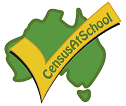 Over 32,000 samples have been downloaded from the Random Sampler on the CensusAtSchool website since the 2008 data was released in July. Now is the time to keep using the data and plan for the year ahead. You may use the prepared classroom activities from the CensusAtSchool website exactly as they are or modify them to suit your needs. Alternatively you may like to let your students construct their own investigation - the analysis possibilities are endless. Why not leave the investigation topic in your students' hands and have them present their finding to the class? You will see that the skills acquired through CensusAtSchool go beyond mathematical ability and data awareness. Students are encouraged to think critically, interpret information, communicate findings and enhance presentation skills...depends where you want to take it! For example, in the activity Comparative Shopping, students are asked to create two Christmas brochures for the Zen electronic trading company, targeting specific communities. The brochures are then presented to the 'board' (the teacher and the rest of the class) for consideration.
Over 32,000 samples have been downloaded from the Random Sampler on the CensusAtSchool website since the 2008 data was released in July. Now is the time to keep using the data and plan for the year ahead. You may use the prepared classroom activities from the CensusAtSchool website exactly as they are or modify them to suit your needs. Alternatively you may like to let your students construct their own investigation - the analysis possibilities are endless. Why not leave the investigation topic in your students' hands and have them present their finding to the class? You will see that the skills acquired through CensusAtSchool go beyond mathematical ability and data awareness. Students are encouraged to think critically, interpret information, communicate findings and enhance presentation skills...depends where you want to take it! For example, in the activity Comparative Shopping, students are asked to create two Christmas brochures for the Zen electronic trading company, targeting specific communities. The brochures are then presented to the 'board' (the teacher and the rest of the class) for consideration.
Please note that for the first time, students can use the Random Sampler to make comparisons between themselves and their international peers. If you would like to find out more about making international comparisons, please visit the International Project page.
Student Feedback
Real data helps bridge the gap between textbook learning and real life. When students conduct real investigations that are relevant to themselves, they are engaged in their learning. Here is what Year 10 students at Catherine McAuley, Westmead had to say about their CensusAtSchool learning experience:
"The idea of using real data however, was more of an incentive of actually paying attention to what you’re doing instead of just writing in answers and not really realising what you’re saying."
"I liked how we had a real - life data sample to work with. The fact that we also took part in the survey that we used also made it feel like it was relevant to us."
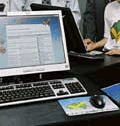 "Real data is useful and makes it more meaningful". "Real data is useful and makes it more meaningful".
"Also using real data as opposed to made up or text book data made it a bit more significant." |
|
New Professional Development Tutorials now available on TeacherTube
If you've experienced difficulty viewing the CensusAtSchool Professional Development tutorials due to blocks placed on YouTube at your school, you'll be pleased to know that the videos are now available for viewing from TeacherTube. Since uploading the videos on TeacherTube in September, there have been hundreds of views for each tutorial. Whether you're wanting to learn more about using CensusAtSchool data in the classroom or just aiming to build Microsoft Excel skills, the tutorials will cater for your needs. To access the range of tutorials simply visit teachertube.com and type 'CensusAtSchool' into the search field.
New Professional Development outline
The 2008 CensusAtSchool Professional Development (PD) outline is now available from the Professional Development Support Materials page, together with simplified teacher and presenter work samples in MS Excel format. These are designed to let you run your own PD sessions with staff at your school if attending a workshop is not possible. Using these support resources, you can help build the skills of your colleagues to the level where they will be confident to use CensusAtSchool data in a spreadsheet. Other PD support resources include spreadsheets our Teacher Consultants use at conference workshops to demonstrate how easily CensusAtSchool data can be used in the classroom.
| How to get involved: Generate a Random Sample from the Student Area of the website. Please contact the CensusAtSchool Team if you have a query or if you would like to provide some feedback. We'd love to hear from you. |
2. Incorporating ABS data into the Financial and Consumer Literacy Framework
 Following a 2004 inquiry into how Australians manage their money, the Australian Government committed $2 million in 2007-08 to develop a national approach to provide teachers with the knowledge and skills required to deliver consumer and financial literacy learning for students. As a result, the Consumer and Financial Literacy Professional Learning Program was developed to achieve the government's financial literacy learning goals. Following a 2004 inquiry into how Australians manage their money, the Australian Government committed $2 million in 2007-08 to develop a national approach to provide teachers with the knowledge and skills required to deliver consumer and financial literacy learning for students. As a result, the Consumer and Financial Literacy Professional Learning Program was developed to achieve the government's financial literacy learning goals.
The framework has four dimensions that correlate to four areas of study, namely: (i) Understanding Money, (ii) Consumer Behaviour (iii) Personal Finance and (iv) Money Management. The financial concepts underpinning the areas of study can be explored using a wide range of ABS data to engage students by giving access to current and relevant information.
A collaboration between the Australian Bureau of Statistics (ABS) and a member of the Victorian Information Technology Teachers Association (VITTA) culminated in a presentation about financial and consumer literacy at the 2008 VITTA Conference. The attendees were shown how the four dimensions of financial literacy can be incorporated in the domains of Economics and ICT. The second part of the presentation focused on how ABS and CensusAtSchool data can be used as a teaching resource for the financial and consumer literacy framework in the four areas of study. ABS data can serve as a 'springboard' for student investigations or can be used as a reference point for generating class discussions surrounding financial literacy issues. CensusAtSchool data is another useful resource as the 2008 questionnaire included new questions about student income sources and amounts received/earned in the week prior to completing the questionnaire. These two questions, coupled with other variables, provide yet another data source that can be used in the areas of understanding the nature and function of money, budgeting (personal finance) and e-commerce.
View the VITTA 2008 presentation slides:

(Powerpoint file size 3.43 MB) |
 |
3. An Idea for the Classroom
This idea could be used as an introductory activity in a Home Group or Humanities (SOSE, HSIE) class, or in a Maths class. It draws on data from the Social Datasets as well as from CensusAtSchool.
How do adults spend their time? Are there differences between women and men? How do your students spend their time? Are there differences between boys and girls? Are your students typical?
The graph below is from Social Dataset S7 which includes survey data from 1992, 1997 and 2006 on how Australians use their time. Students could use the data table to develop a similar graph. What changes have occurred between the two surveys? What are the differences between men and women? Have these differences changed or remained the same over time? Students could also compare 1992 with 1997 and 2006.
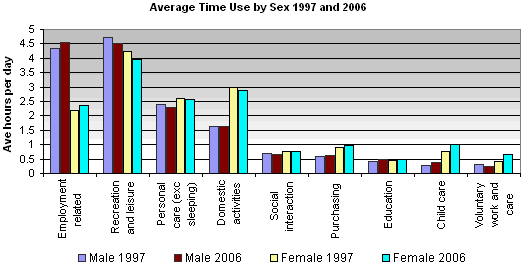
Similar time use questions were asked in the 2008 CensusAtSchool questionnaire. Students were asked to estimate the number of hours per week they spent doing various activities. The graph below plots the average number of hours for a sample of boys and a sample of girls from Years 8, 9 and 10. You may wish to draw a sample of just one year level to compare with your students. Again students can examine the difference between boys and girls with respect to the average number of hours spent in each activity. How do your students compare? This activity also presents a great chance to discuss with your students the idea of variability in data. How 'typical' is this average? What is the spread of the data? Variability is a notoriously difficult concept for students and this real data offers the chance to improve student understanding.
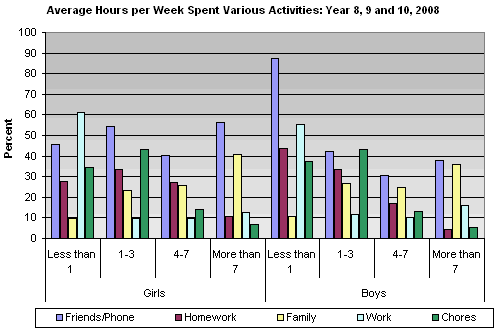
Do you have a classroom idea that uses ABS data or ABS Education products? Let us know at education@abs.gov.au and we can share it with schools around Australia.
4. Free Teacher Professional Development Days at ABS
Don't miss out on these extremely successful and useful sessions. Following the successful Teacher Librarian Information Sessions that were conducted across Australia last year, ABS Education Services has now extended the program to include professional development sessions for Economics/Business Studies/Commerce teachers as well as Teacher Librarians.
These workshops are computer based, hands-on and absolutely FREE. Since December, 2005 all ABS publications have been available to download without charge from the ABS website. This website now includes all publications from 1994 onwards and there are over 1 million pages. This means two things: firstly we are very likely to have what you are looking for but secondly, you may need some tips on how to find it. We are constantly updating and improving the ABS website, and making our data easier to find. In these sessions you will learn how to navigate the ABS website, gain tips on using ABS data in the classroom and discover resources developed especially for teachers. To register your interest or for more information about these workshops please contact the appropriate person in your state, or call Education Services on 1800 623 273 or send an email to education@abs.gov.au.
Teacher Librarian Information Workshops
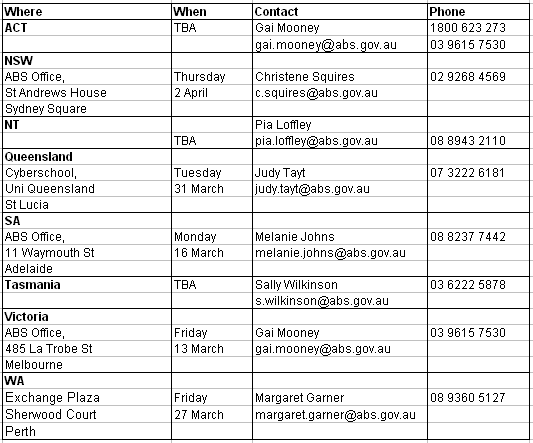
Information Workshops for Economics / Business Studies/ Commerce / SOSE
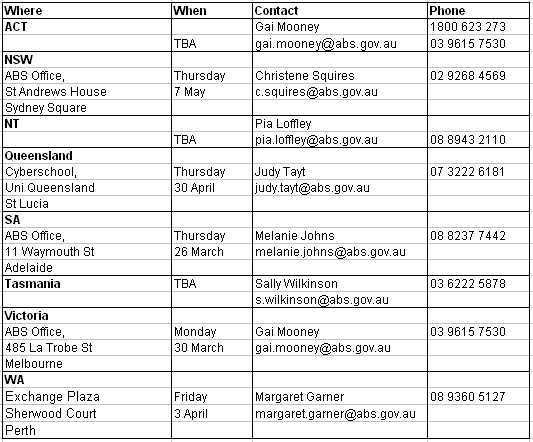
5. New Senior Business Studies Resources
| New thematic links to relevant ABS publication for business studies have been added to Senior Curriculum Resources. Topics include: General resources for senior business studies courses, Nature of Business, Operations & Financial Management/ Environment, Managing People & Change, Communication & Marketing, and Innovation. Each topic is available in Word format and provides a list of hyperlinks to ABS publications, accompanied by a description. These are designed to quickly help teachers and students find the information they need without searching the ABS home page. |
6. Visit from the Victorian Commercial Teachers Association
Thirty teachers were treated to 2 excellent and informative talks when they visited the ABS offices in Melbourne as part of the annual 2008 Comview conference of Victorian Commercial Teachers Association (VCTA) . First Mr William Milne (Acting Director, Annual Integrated Collections Branch, ABS) spoke on 'CPI: The reality beyond the text book' and then Mr Ben Ferguson (Acting Assistant Director, EFP - Climate Change, Department of Treasury and Finance) presented an enthralling talk on 'The Economics of Sustainability'. (The presentations are attached below.)
Feedback from participants was that the morning was not only very useful professionally, but also most enjoyable.

(Powerpoint file size 499KB) | 
(Powerpoint file size 104KB) |
|
7. Upload CensusAtSchool Data into you calculator
Senior secondary students can upload a random sample of CensusAtSchool data into their calculator for analysis. The CasioED website has published an article with detailed instructions and activities that incorporate CensusAtSchool with their ClassPad calculator range. Article In Pursuit of Beauty is located under the Statistics tab from 'One Lesson Wonders'. The activities are based on 2006 CensusAtSchool data, drawing on gender and physical characteristics variables.
The first activity explores whether correlation exists between gender and dyed hair, with students comparing how much the actual data varies from the expected. The second exercise uses CensusAtSchool data to test the principles of the Golden Ratio.
To upload the data, you will need a spreadsheet program such as Microsoft Excel or Lotus 1-2-3, which will not prove difficult since the random sample can be saved directly as an Excel (.xls) file. Although it's still early days, it is envisaged that students could use a wide range of calculators to upload CensusAtSchool data as another medium for analysis, particularly at the middle-years to senior levels.
8. Conference Participation |
Have you caught up with Education Services at a conference yet? Since the last newsletter staff have presented at a number of conferences around the country.
VITTA
The 2008 'VITTA Annual Conference, 'Shift Happens' , was held between the 24 - 26 November at the Rydges Bell City, in Melbourne. Over 250 speakers presented a range of sessions for educators to choose from. Two Education Services staff presented sessions on the first day of the conference. Teacher Consultant, Pat Beeson, discussed the application of spatial technology in the classroom using Census data, whilst Liya Perelman co-presented with VITTA member (and teacher) Antonia Caridi. The latter presentation focused on the new Consumer and Financial Literacy framework, and how ABS data can be used as a reference for the four key areas of study, including financial data from the CensusAtSchool database.
Comview
Comview attracted approximately 1000 participants over two days in November, at La Trobe University in Melbourne. Over 300 conference participants attended the ABS trade display to find out what resources were available to them. Many said although they would like to use ABS resources, they are still finding it daunting. Hence the upcoming Workshops for Economics teachers and the Web Guide, a poster designed to assist users with website navigation and resources, particularly pleased the participants. If you would like a free copy of the WebGuide, please contact Education Services. Manager and ex-teacher, Gai Mooney, also presented a workshop to teachers about the range of free resources and services available from the Education Services website.
MAV
The Mathematical Association of Victoria (MAV) hosted their MAV Annual Conference on 4-5 December, also at La Trobe University. Union Hall was transformed into a math's teachers dream, with all kinds of exhibitors filling up the room - ABS Education Services being one them. The ABS booth had much to offer passersby, including demonstrations on the free CensusAtSchool Random Sampler facility and various other free products (such as The Tale of Two Worlds CD). As usual, ABS Teacher Consultants, Ian Wong and Pat Beeson, conducted several professional development workshops and presentations to teachers throughout the conference. Ian's workshop focused on building Excel skills using CensusAtSchool data, whilst Pat's presentation combined Mathematics and Geography to build an understanding of spatial data.
9. Recently Released Publications
Remember,
all ABS publications are
free to download from the
ABS website.
Environment and Energy News Environment and Energy News is the newsletter of the ABS Centre of Environment and Energy Statistics (CEES). It is published twice a year and highlights developments in environment and energy statistics particularly at the ABS.
Household use of Information Technology, Australia, 2007- 2008 (cat. no. 8146.0) Presents statistics on household use of information technology. Includes the number of households with internet and computer access, presented by household and geographical characteristics.
Demography News, November 2008 (cat .no 3106.0) This quarterly newsletter provides information about the latest demographic research and analysis being undertaken by the Australian Bureau of Statistics.
Education and Work 2008 (cat 6227.0) Provides selected information on participation in education, highest educational attainment, transition from education to work and current labour force and demographic characteristics for the civilian population aged 15-64 years.
You can view the full range of previously released publications and upcoming releases from the ABS home page under Product Releases.
10. Contact details
Education News is a totally free resource that aims to assist teachers use ABS data in their classroom. When you subscribe you will be notified of each new edition as it is published.
 Print Page
Print Page
 Print All
Print All